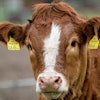
The U.S. Grains Council (USGC) recently dispatched a delegation to Gujarat, India, to investigate the potential for exporting distiller’s dried grains with solubles (DDGS) to the Indian dairy industry. This initiative aims to provide a nutritious supplement to cattle diets in India, where there is a significant demand for dry fodder in the livestock sector.
“Currently, there is no market access for U.S. DDGS in India, but there is massive demand for dry fodder in the livestock industry,” said Reece Cannady, USGC regional director for South Asia. “As the most populous country in the world, it’s impossible to understate the opportunity in front of us to open a brand-new market for U.S. agriculture.”
The delegation was led by Cannady and John Szczepanski, Director of the U.S. Forage Export Council (USFEC). They were joined by USGC Marketing Specialist Nayantara Pande, USGC Regional Consultant Amit Sachdev, USGC Administrative Assistant Pallavi Mahindru, POET Technical Services Director Dr. Kevin Herrick, and Viviza Services Consultant Dr. Pradeep Mahajan.
During their visit, the group toured a feed plant and engaged with management staff and animal nutritionists to understand the industry's current feed formulas and potential future needs. They also visited several local farms and processing centers to gain a comprehensive view of the dairy industry from start to finish.
The delegation spent the following two days at AMUL, India's largest dairy cooperative and one of the largest dairy product manufacturers in the world. They toured AMUL’s dairy facilities, chocolate plants, and calf rearing center, which had received support from the USGC in 2017 and now leads India’s dairy cattle genetics program. Presentations were given to AMUL’s leadership on the nutritional benefits and availability of U.S. DDGS.
“DDGS are packed with protein, environmentally friendly, and abundantly available from U.S. producers, all significantly attractive factors to the Indian dairy industry,” Cannady said.
“Opening the Indian market to U.S. DDGS would be a win for U.S. producers and exporters and for Indian producers looking for additional dry ingredients that will improve livestock health, dairy quality, and milk yields.”
This exploratory visit marks a significant step toward creating new market opportunities for U.S. agriculture while providing the Indian dairy industry with high-quality feed supplements that could enhance productivity and sustainability.
















